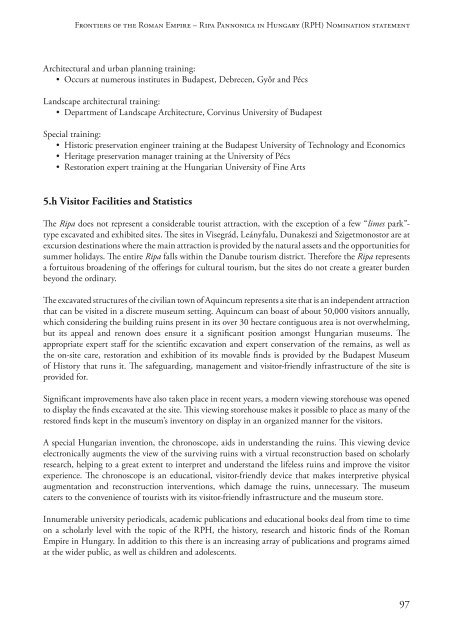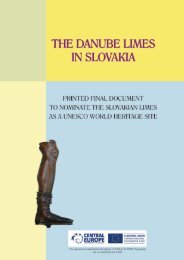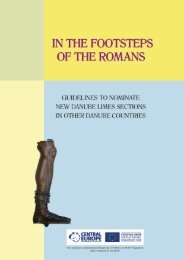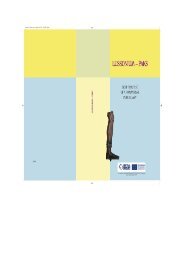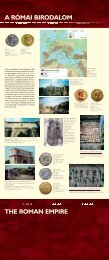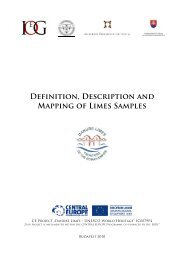the PDF version! - Danube Limes
the PDF version! - Danube Limes
the PDF version! - Danube Limes
You also want an ePaper? Increase the reach of your titles
YUMPU automatically turns print PDFs into web optimized ePapers that Google loves.
Frontiers of <strong>the</strong> Roman Empire – Ripa Pannonica in Hungary (RPH) Nomination statement<br />
Architectural and urban planning training:<br />
• Occurs at numerous institutes in Budapest, Debrecen, Győr and Pécs<br />
Landscape architectural training:<br />
• Department of Landscape Architecture, Corvinus University of Budapest<br />
Special training:<br />
• Historic preservation engineer training at <strong>the</strong> Budapest University of Technology and Economics<br />
• Heritage preservation manager training at <strong>the</strong> University of Pécs<br />
• Restoration expert training at <strong>the</strong> Hungarian University of Fine Arts<br />
5.h Visitor Facilities and Statistics<br />
The Ripa does not represent a considerable tourist attraction, with <strong>the</strong> exception of a few “limes park”-<br />
type excavated and exhibited sites. The sites in Visegrád, Leányfalu, Dunakeszi and Szigetmonostor are at<br />
excursion destinations where <strong>the</strong> main attraction is provided by <strong>the</strong> natural assets and <strong>the</strong> opportunities for<br />
summer holidays. The entire Ripa falls within <strong>the</strong> <strong>Danube</strong> tourism district. Therefore <strong>the</strong> Ripa represents<br />
a fortuitous broadening of <strong>the</strong> offerings for cultural tourism, but <strong>the</strong> sites do not create a greater burden<br />
beyond <strong>the</strong> ordinary.<br />
The excavated structures of <strong>the</strong> civilian town of Aquincum represents a site that is an independent attraction<br />
that can be visited in a discrete museum setting. Aquincum can boast of about 50,000 visitors annually,<br />
which considering <strong>the</strong> building ruins present in its over 30 hectare contiguous area is not overwhelming,<br />
but its appeal and renown does ensure it a significant position amongst Hungarian museums. The<br />
appropriate expert staff for <strong>the</strong> scientific excavation and expert conservation of <strong>the</strong> remains, as well as<br />
<strong>the</strong> on-site care, restoration and exhibition of its movable finds is provided by <strong>the</strong> Budapest Museum<br />
of History that runs it. The safeguarding, management and visitor-friendly infrastructure of <strong>the</strong> site is<br />
provided for.<br />
Significant improvements have also taken place in recent years, a modern viewing storehouse was opened<br />
to display <strong>the</strong> finds excavated at <strong>the</strong> site. This viewing storehouse makes it possible to place as many of <strong>the</strong><br />
restored finds kept in <strong>the</strong> museum’s inventory on display in an organized manner for <strong>the</strong> visitors.<br />
A special Hungarian invention, <strong>the</strong> chronoscope, aids in understanding <strong>the</strong> ruins. This viewing device<br />
electronically augments <strong>the</strong> view of <strong>the</strong> surviving ruins with a virtual reconstruction based on scholarly<br />
research, helping to a great extent to interpret and understand <strong>the</strong> lifeless ruins and improve <strong>the</strong> visitor<br />
experience. The chronoscope is an educational, visitor-friendly device that makes interpretive physical<br />
augmentation and reconstruction interventions, which damage <strong>the</strong> ruins, unnecessary. The museum<br />
caters to <strong>the</strong> convenience of tourists with its visitor-friendly infrastructure and <strong>the</strong> museum store.<br />
Innumerable university periodicals, academic publications and educational books deal from time to time<br />
on a scholarly level with <strong>the</strong> topic of <strong>the</strong> RPH, <strong>the</strong> history, research and historic finds of <strong>the</strong> Roman<br />
Empire in Hungary. In addition to this <strong>the</strong>re is an increasing array of publications and programs aimed<br />
at <strong>the</strong> wider public, as well as children and adolescents.<br />
97


